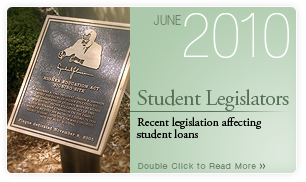Student Legislators | Recent legislation affecting student loans
The College Cost Reduction and Access Act aimed to make student loans less costly to students and to increase the amount of financial support available. Providing $20 billion in aid to students in increased Pell Grants, it reduced the interest for subsidized Stafford loans, capped loan repayment amounts at a specific percentage of income and extended loan forgiveness to people who hold public service jobs for 10 years. It also extended deferment of repayment for members of the armed services until 180 days after demobilization.
Student Loan provisions formed part of the healthcare reform legislation reconciliation. Though they did not receive as much media attention as other parts of the legislation, they substantially affected the student loan system. For one, the William D. Ford Federal Loan Program became the sole student loan program backed by the federal government, eliminating private lenders who were subsidized by the government but offered loan rates and terms that were less favorable to students. This will save $68 billion over the next 11 years. Other benefits include 820,000 additional Pell Grant recipients and improved repayment terms for loans made after July 1, 2014. In addition, the limits for Pell grants will be raised over the next seven years and $2 billion will be spent toward community colleges in the next few years.

